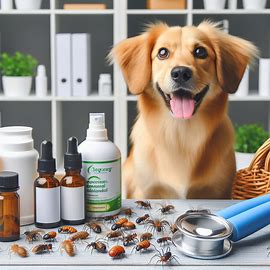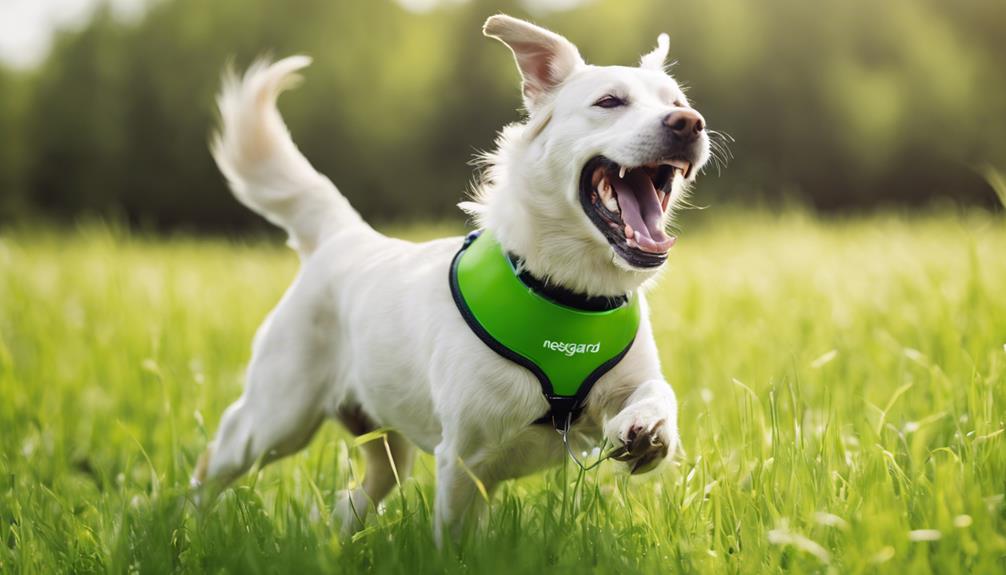Is Your Dog Really Safe From Fleas In Winter?
Keep your dog safe from fleas in winter by staying vigilant. Fleas can still pose a threat during colder months. Maintain regular prevention measures and watch for signs of infestation. Remember, indoor and outdoor factors can contribute to flea risk. Continue flea treatments, wash bedding in hot water, and vacuum frequently. Grooming helps with flea detection too. Your vet can provide tailored advice and effective prevention methods. Stay proactive to protect your furry friend. Learn more about hidden risks and winter flea prevention to ensure your dog's well-being.
Key Takeaways
- Fleas can remain dormant in winter but may still be active indoors.
- Outdoor exposure to wildlife and other dogs increases flea risk in winter.
- Regular preventive measures like washing bedding and vacuuming are essential.
- Vet-recommended flea treatments provide year-round protection against infestations.
- Consulting a vet ensures effective flea control tailored to your dog's specific needs.
Flea Lifecycle in Winter
When winter arrives, fleas tend to have a dormant lifecycle, making it seem like they've disappeared. However, this doesn't mean they're completely gone. Fleas can remain dormant in their pupae stage for several months, waiting for the right conditions to emerge. Once the temperature and humidity levels are favorable, these pesky creatures can quickly become active again, infesting your furry friend.
It's crucial to understand that even though fleas may not be as active during winter, they're still present in your environment, just waiting for the opportunity to thrive. This means that your dog isn't entirely safe from flea infestations even in the colder months. Regular prevention and monitoring are essential to keep your pet protected year-round.
To ensure your dog's safety, continue using flea prevention methods throughout the winter season. Regularly check your pet for any signs of fleas or flea dirt, especially after outdoor activities. By staying vigilant and proactive, you can help keep your dog flea-free even when the temperatures drop.
Indoor Flea Risk Factors
Remaining vigilant against indoor flea risk factors is crucial to safeguarding your dog's well-being during the winter months. While outdoor exposure is reduced in colder weather, indoor spaces can still pose a threat. Carpets, rugs, and upholstery provide ideal hiding spots for flea eggs and larvae to thrive. Your dog's bedding and favorite resting areas are also common grounds for fleas to lay eggs. Regularly washing and vacuuming these areas can help eliminate flea populations before they become a problem.
Additionally, other pets or even humans can inadvertently introduce fleas into your home. Visitors with pets or outdoor cats wandering indoors can bring fleas along with them. It's essential to keep an eye out for any signs of fleas on your dog, such as excessive scratching or visible bite marks.
Outdoor Flea Risk Factors
To protect your dog from fleas during winter, being aware of outdoor flea risk factors is essential. Even in colder months, outdoor spaces can harbor fleas that pose a threat to your furry friend.
One significant risk factor is wildlife, such as rodents or stray animals, that may carry fleas and introduce them to your yard. Additionally, areas with tall grass, bushes, or leaf piles create ideal environments for fleas to thrive. These pests can easily latch onto your dog as they explore these outdoor spaces.
Moreover, places where other dogs frequent, like parks or walking trails, increase the likelihood of flea exposure. Fleas can hitch a ride on other animals and be transferred to your pet during encounters.
Signs of Flea Infestation
After being exposed to outdoor flea risk factors, your dog may exhibit signs of flea infestation that require immediate attention. Keep an eye out for excessive scratching, biting, or licking, especially around the tail, belly, or inner thighs. Fleas can also cause red and irritated skin, leading to hair loss in affected areas.
If you notice small dark specks on your dog's fur or skin, known as flea dirt, it's a strong indicator of a flea problem. Additionally, you might spot actual fleas moving through your dog's coat or see red, raised bumps on their skin from flea bites. Some dogs may develop allergic reactions to flea saliva, resulting in intense itching and discomfort. In severe infestations, you might even observe lethargy, pale gums, or visible parasites on your pet.
If you suspect your dog has fleas, consult your veterinarian promptly for appropriate treatment and prevention strategies.
Winter Flea Prevention Tips
Winter is a crucial time to implement effective flea prevention strategies for your dog's well-being. Just because it's cold outside doesn't mean your furry friend is safe from fleas. These pesky parasites can still find their way onto your dog and into your home during the winter months. To keep your dog flea-free, here are some tips to follow:
- Continue Flea Treatment: Even in winter, it's important to stick to your dog's flea prevention routine. Consult with your vet to ensure the treatment is still effective during the colder months.
- Regularly Wash Bedding: Wash your dog's bedding frequently in hot water to kill any flea eggs or larvae that may be present.
- Vacuum Frequently: Make sure to vacuum your home regularly, paying close attention to areas where your dog spends time. This can help remove any flea eggs or larvae that may be hiding in carpets or furniture.
Grooming for Flea Detection
Don't overlook the importance of regular grooming in checking for fleas on your dog, ensuring their continued protection even during the winter months. Grooming your dog regularly not only keeps their coat healthy but also provides an opportunity to inspect for any signs of fleas or flea dirt. Use a flea comb to carefully comb through your dog's fur, paying close attention to areas like the neck, tail, and belly where fleas often hide. If you notice any small black specks that resemble dirt but turn red when moistened, it could be flea dirt, indicating a flea infestation.
Additionally, while grooming, be on the lookout for any excessive scratching, redness, or irritated skin, as these could be signs of fleas or other skin issues. If you do find fleas or suspect an infestation, consult your veterinarian for the best course of action to protect your dog and eliminate the fleas effectively. Regular grooming not only helps in flea detection but also strengthens the bond between you and your furry companion.
Natural Flea Repellents
To naturally repel fleas from your dog, consider incorporating essential oils and herbal remedies into your grooming routine. Essential oils like lavender, peppermint, cedarwood, and lemongrass are known for their flea-repelling properties. Dilute a few drops of the chosen essential oil in water and spray it on your dog's fur, avoiding the eyes and mouth. Alternatively, you can add a few drops to your dog's shampoo during bath time.
Herbal remedies such as rosemary, chamomile, and neem are also effective in deterring fleas. You can create a herbal flea collar by soaking a bandana in a mixture of water and herbal essential oils, then allowing it to dry before tying it around your dog's neck. Additionally, planting flea-repelling herbs like mint, basil, or sage in your yard can help create a natural barrier against these pests.
Remember to always consult with your veterinarian before using any essential oils or herbal remedies on your dog, especially if they've any underlying health conditions or are pregnant. By incorporating these natural flea repellents into your grooming routine, you can help keep your dog flea-free in a safe and chemical-free way.
Veterinary Flea Treatment Options
Consider consulting your veterinarian for effective flea treatment options to ensure your dog remains protected year-round. Veterinary flea treatments come in various forms such as topical solutions, oral medications, collars, and sprays.
Topical solutions are applied directly to your dog's skin, usually between the shoulder blades, and provide long-lasting protection against fleas. Oral medications, on the other hand, are ingested and work from the inside out to kill fleas when they bite your dog.
Flea collars release active ingredients that repel and kill fleas, offering continuous protection. Additionally, flea sprays can be used to treat your dog's environment, killing fleas in bedding, carpets, and furniture to prevent reinfestation.
Your veterinarian will recommend the most suitable flea treatment based on your dog's age, size, health status, and flea infestation level. It's essential to follow their instructions carefully to ensure the treatment is administered correctly and effectively. By using veterinary flea treatment options, you can safeguard your dog from fleas not only in winter but all year long.
Consulting Your Vet
When seeking advice on flea treatment for your dog, consulting your vet is crucial for tailored recommendations. Your vet has the expertise to assess your dog's specific needs, taking into account factors such as age, weight, health conditions, and lifestyle. They can recommend the most effective flea prevention methods and products that are safe for your furry friend.
Vets can also provide guidance on proper application techniques and dosages to ensure the treatment's effectiveness without causing harm. Additionally, they stay updated on the latest advancements in flea control, allowing them to offer the best solutions for your dog.
Conclusion
So, even though winter may seem like a safe time for your dog when it comes to fleas, it's important to remember that they can still be a threat.
By being aware of the risks, taking preventative measures, and consulting your vet for advice, you can ensure that your furry friend stays flea-free all year round.
Don't let your guard down just because it's cold outside – keep your dog protected from fleas no matter the season.








